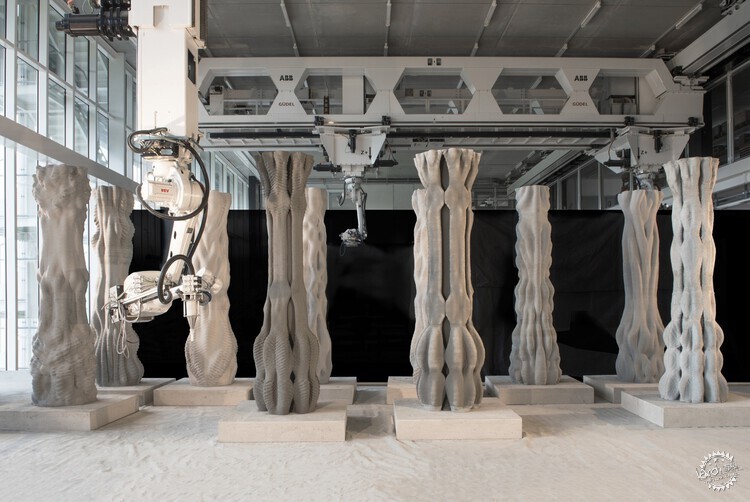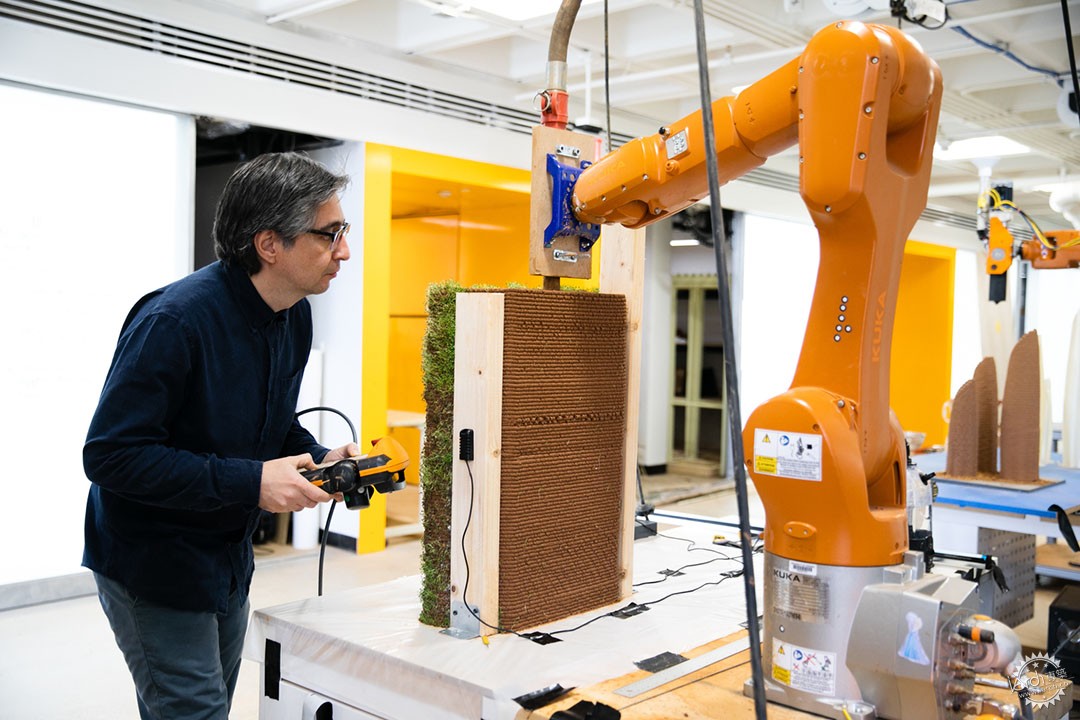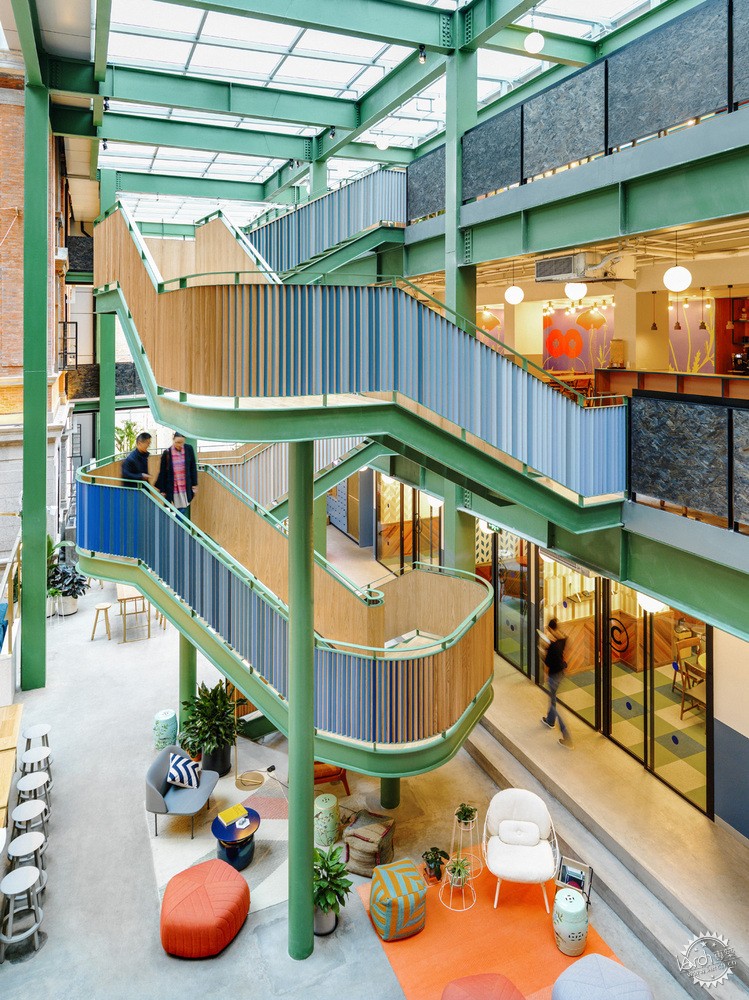
Image © Benjamin Hofer
什么是建筑技术?技术如何改变行业
What is Architectural Technology? How Technology is Changing the Industry
由专筑网Zia,小R编译
AEC行业的专业人士很清楚困扰建筑环境的问题。建筑业是最大的材料消费者,并产出大约40%的碳排放量,这是一个普遍的事实。建筑工程也是巨大的废物生产者,所以可以从循环设计中受益。几乎四分之三的建筑项目都会超出预算,近一半的建筑支出并入了管理费用。在一个快节奏的世界里,建筑行业面临着多方面的挑战,技术和数字化可以提供重要的解决方案。
建筑业在适应数字化浪潮方面非常缓慢。2015年,麦肯锡发布了数字化指数,将设计和建筑行业在数字化的进展中排在末位。建筑行业的劳动力正在老龄化,项目需求的增加和复杂性提高,而员工的生产力下降。即使前景充满了不情愿和不确定的因素,数字化的推动也势在必行。
Professionals in the AEC industry are well aware of the issues that grapple the built environment. That the construction industry is the largest consumer of materials and is responsible for 40% of all carbon emissions is a commonplace fact. Construction work is also a large waste generator and could greatly benefit from circular design principles. Almost three-quarters of all construction projects tend to be over budget, and nearly half of the spending on buildings goes into the overheads. In a fast-paced world with multi-faceted challenges, technology, and digitization seek to deliver significant solutions.
The construction industry has notoriously been slow to adapt to the wave of digitization spreading across various fields. In 2015, McKinsey’s published their digitization index and placed the design and construction industry at the bottom in the progress toward digitization. The workforce in the construction sector is aging, an increase in project demand and complexity are growing, and employee productivity is falling. Even as reluctance and uncertainty plague the industry, a digital push is intensifying.
什么是建筑技术?
What is Architectural Technology?

Image © Axel Crettenand
认识到在数字时代利用技术的关键性,建筑技术已经作为一个研究领域出现,研究技术和设计如何互动。这门相对较新的学科涉及建筑的解剖学和生理学以及它们的生产和性能。在设计、工程和科学的交叉点上,建筑技术试图增强设计过程的自动化,以加快施工和管理,并确保材料、系统和结构的高性能。建筑过程的数字化与生产、性能、环境可持续性和经济效率有关。
建筑技术本身就是一门庞大的学科。目前,建筑信息模型(BIM)、计算机辅助设计、机器人制造、建筑性能分析和人工智能等创新技术在该学科中占主导地位。一些研究课题正在进行中,探索技术是设计过程的未来。
利用技术来实现建筑的复杂性,改善专业合作,并使用具有成本效益的设计方法是显著的优势。未来的应用将越来越需要处理大量的复杂数据,预测设计模型,考虑再生系统,并将增强现实与物理世界融合。
Recognizing the criticality of harnessing technology in the digital age, architectural technology has emerged as a field of study that examines how technology and design interact. The relatively new discipline deals with the anatomy and physiology of buildings and of their production and performance. At the intersection of design, engineering, and science, architectural technology seeks to automate and augment the design process to quicken construction, support management, and ensure high-performance of materials, systems, and structures. The digitalization of the architectural process relates to production, performance, environmental sustainability, and economic efficiency.
Architectural technology is a vast discipline in itself. At present, innovations like Building Information Modelling (BIM), computational design, robotic fabrication, building performance analysis, and artificial intelligence dominate the discipline. Several topics of research are underway, exploring a future where technology is inherent to the design process.
The use of technology to achieve complexity in architectural forms, improve professional collaboration, and use cost-effective design approaches are notable advantages. Future applications will increasingly need to handle large amounts of complex data, predict design models, account for regenerative systems, and blend augmented reality with the physical world.

Image © Axel Crettenand
"随着技术在数量和复杂性上的倍增,建筑行业开始变得零散",Stephen Emmitt写道,他在《建筑技术:研究与实践》一书中指出了新学科的诞生。Emmitt阐述了设计和技术之间的关系,将其追溯到工业革命时期。钢铁和钢筋混凝土等建筑材料以及电梯等机械配件的发明引发了技术对21世纪建筑的影响。
一些从业者将建筑技术的诞生追溯到维特鲁威的理论时期。他对建筑类型、风格、材料和施工技术的分类对许多学科的发展产生了重大影响,包括土木工程、结构工程、建筑技术和其他实践。
砖、石、木材和钢材是二十世纪初之前主要使用的建筑材料。建筑方法依赖于手工劳动、不太复杂的工具和从当地获得的材料。现代建筑技术要复杂得多,建筑物的墙壁、地板和屋顶由许多部件和构造组成。随着建筑方法的进步,向技术设计的转变是至关重要的。
“As technologies multiplied in number and complexity, the building profession started to fragment", writes Stephen Emmitt, pointing to the inception of the new discipline in his book Architectural Technology: Research and Practice. Emmitt elaborates on the relationship between design and technology, tracing it back to the Industrial Revolution. The invention of building materials like steel and reinforced concrete as well as mechanical accessories like elevators sparked the influence of technology in 21st-century architecture.
Some practitioners date the birth of architectural technology to the time of Vitruvius’ theories on the topic. His classification of building typologies, styles, materials, and construction techniques had a significant impact on the development of numerous disciplines, including civil engineering, structural engineering, architectural technology, and other practices.
Brick, stone, timber, and steel were the main building materials utilized until the turn of the twentieth century. Construction methods relied on manual labor, less sophisticated tools, and regionally obtained materials. Modern building techniques are far more intricate, with the walls, floors, and roofs of a building made of numerous components and layers. As architecture methodologies advance, a shift towards designing with technology is vital.
技术正在改变建筑业
Technology is Changing the Architecture Industry

Image © Tom Daly
技术正在从根本上改变我们所知的AEC行业。数据驱动的设计使建筑的建造能够使用用户和环境数据,以有效地实现性能指标。这种方法使结构的建造更加有效,决策更加迅速,使用者也更加舒适。数据构成了WeWork设计过程的关键,新建筑的选址、周边设施的便利程度、施工顺序和室内设计都可以获得的信息为指导。
此外,传统的建筑业务模式、交付方法和通信系统都是以满足特定的要求和交付成果为导向。因此,建筑服务在保持质量和项目时间表的同时面临着扩展性的困难。像BIM和可视化工具这样的技术已经成为该行业的标准做法。它们没有从根本上改变设计流程,而是逐渐增强了当前的设计服务和商业模式。
Technology is radically changing the AEC industry as we know it. The data-driven design has enabled buildings to be built to implement user- and contextual data to efficiently achieve performance metrics. This approach allows for structures to be constructed more effectively, decisions to be made more quickly, and residents to be made more comfortable. Data forms the backbone of WeWork's design process. Decisions about sites of new buildings, proximity to amenities, construction sequence, and interior design are guided by acquired information.
Further, traditional architectural business models, delivery methods, and systems of communication have been oriented toward meeting specific requirements and outdated deliverables. As a result, architectural services face difficulty in scalability while maintaining quality and project timelines. Technologies like BIM and visualization tools have become standard practice in the industry. Rather than fundamentally altering the design process, they have gradually enhanced the current design services and business models.

Image Courtesy of Fologram
虽然有数以千计的新商业模式,但目前业界有一些专注于将建筑作为按需产品提供的企业——如Blockable和Wikihouse,专注于端到端的建筑流程——如WeWork和Katerra,还有为AEC行业提供知识市场的企业——如Hypar和BuildX。
技术也在使设计民主化,使其为更多的人所接受。通过自动化和增强设计过程中的传统任务,运营成本下降,从而使设计服务变得更加实惠。在未来,居民可能有能力通过用户数据来影响设计和城市规划,从而扭转了许多城市自上而下的设计模式。
技术不仅改变了建筑业,也改变了建筑师的角色。原本忙于设计、绘图和细部设计的从业人员更多地参与到建筑性能、生产和工艺中。建筑技术专家拥有对建筑设计的专业理解,这些与过程和最终产品都相关。他们将设计和工程领域的工作完美地融合在一起,倡导整体思维,并将概念性的想法与设计执行联系起来。
While thousands of new business models are possible, currently the industry is noticing a significance in ventures focused on providing buildings as on-demand products - like Blockable and Wikihouse, bringing end-to-end construction processes - like WeWork and Katerra, and creating a knowledge market for the AEC industry - like Hypar and BuildX.
Technology is also democratizing design, making it accessible to wider audiences. By automating and augmenting traditional tasks in the design process, operating costs go down thus allowing design services to become more affordable. In the future, citizens may have the power to influence design and city planning through user data, reversing the top-down model many cities are built on.
Technology is altering not just the architecture industry but the role of an architect. Practitioners who were otherwise occupied with design, drafting, and detailing are more engaged in building performance, production, and processes. Architectural technologists possess a specialist understanding that underpins the design of buildings, relating to both the process and the final product. They seamlessly merge efforts between the design and engineering worlds, advocating for holistic thinking and bridging conceptual ideas with design execution.

Image © Jonathan Leijonhufvud
技术需要跨越多个学科的新技能,如数据分析、编码和可视化。建筑师的角色变得更加广泛,使他们能够轻松地与支持性行业合作。在设计过程中,由于技术的原因,数据和性能与直觉和创造力并存。数字化有助于优化传统的工作流程,使重复性工作自动化,并将任务分解为高度专业化的知识。因此,设计可以参与建筑生命周期的每个阶段,而不仅仅是前期。
随着数字化的发展,该行业将走向可以获得建筑性能数据、开源的专业知识和编码、设计在可互操作的平台上运行的未来。居住在建筑环境中的人们将在影响建筑设计方面拥有更多的权力。因此,设计师将需要变得更加积极主动,用批判的眼光来确保建筑和设计对其原则的坚持。建筑业的下一个重大挑战是确保颠覆性的技术能够为广泛的公共利益创造场所和空间。
Technology demands new skills that cross over multiple disciplines such as data analysis, coding, and visualization. The role of the architect becomes broader, allowing them to easily collaborate with supporting industries. Data and performance coexist with intuition and creativity in the design process, owing to technologies. Digitization helps optimize traditional workflows by automating repetitive tasks and breaking down tasks into highly specialized expertise. The design thus becomes involved at every stage of the building lifecycle rather than just the beginning.
As digitization revs, the industry is headed to a future where performance data on every building is available, professional knowledge is open-source and encoded, and design operates on interoperable platforms. The people who inhabit the built environment will have more authority in influencing building designs. As a result, designers will need to become more proactive and use a critical eye to ensure that architecture and design remain honest to its principles. The architecture industry's next major challenge is ensuring that disruptive technologies will enable the creation of places and spaces for the public good.

Image via Shutterstock/Videoflow
|
|
